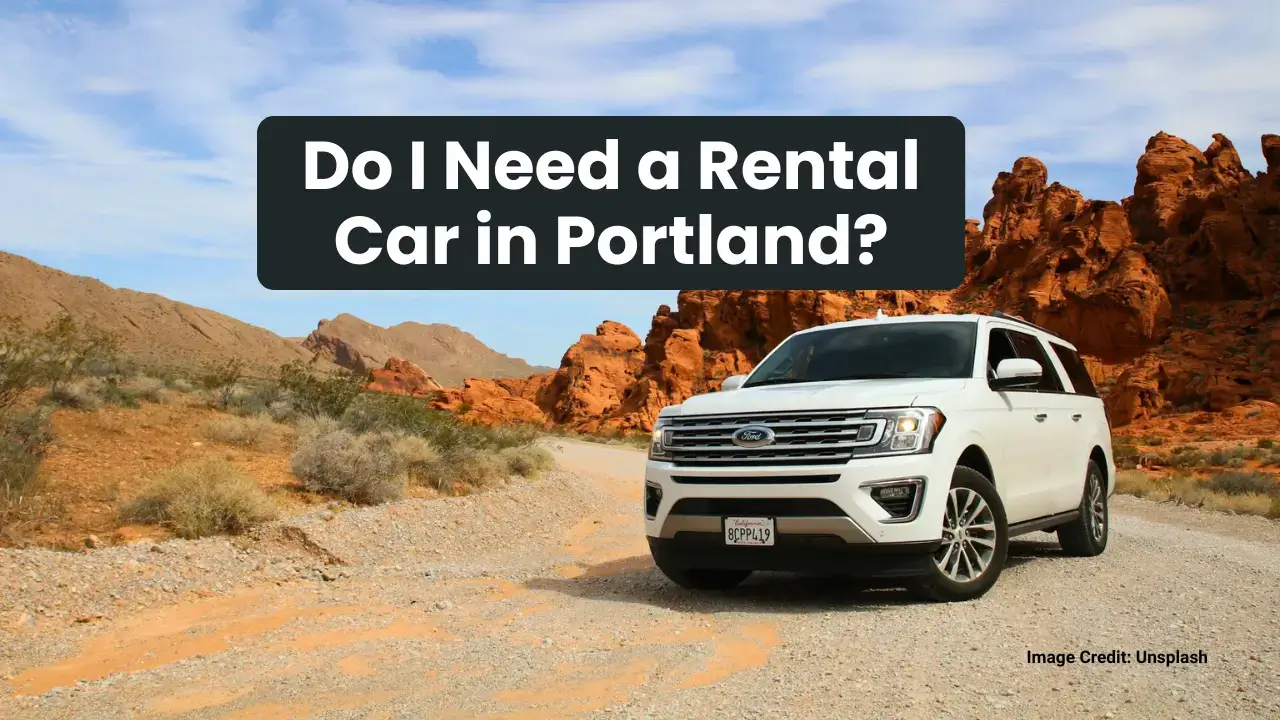Introduction
Thinking of visiting Portland, Oregon? Known for its hip coffee shops, forested parks, craft breweries, and eco-conscious vibe, Portland has become a must-see destination in the Pacific Northwest. But before you start mapping out your dream trip, there’s one big question you’ll need to answer: Do I really need a rental car in Portland?
Here’s the thing—Portland isn’t your typical car-dependent city. Thanks to its progressive approach to urban planning and sustainability, getting around without a car is not only possible—it might actually make your trip easier. But that doesn’t mean a rental car is never necessary. Depending on your plans, where you’re staying, and what you want to explore, a rental car might be super helpful—or just a waste of money and hassle.
In this blog post, we’ll take a deep dive into the transportation scene in Portland. We’ll explore everything from the city’s awesome public transit system to hidden costs of driving, and even what real travelers are saying. By the end, you’ll have a crystal-clear answer tailored to your travel style.
Understanding Portland’s Layout
Before we talk transportation, let’s break down the geography. Portland is divided into five main quadrants: Northwest (NW), Southwest (SW), Northeast (NE), Southeast (SE), and North Portland. These aren’t just compass points—they define how the city is organized and navigated.
At the center is downtown Portland, which is compact, lively, and incredibly walkable. Many of the city’s top attractions—like Powell’s City of Books, the Portland Art Museum, and Tom McCall Waterfront Park—are clustered here. Beyond downtown, you’ve got neighborhoods like Alberta Arts District, Hawthorne, Sellwood, and Mississippi Ave, all loaded with charm, unique shops, and great food.
Most of these neighborhoods are no more than 15–30 minutes apart by car, and many are easily reachable by public transportation or even bike. That’s why a lot of visitors choose to skip the rental car altogether. But there’s a caveat—if you’re staying far outside the city or planning lots of day trips, the equation changes.
So ask yourself: Are you planning to stick to Portland’s neighborhoods, or do you want to hit the mountains and coast? Your answer can help determine whether a rental car makes sense.
The Strength of Portland’s Public Transportation
Here’s where Portland really shines. The city boasts one of the most efficient and user-friendly public transportation systems in the U.S., and it’s called TriMet. The network includes buses, the MAX light rail, and Portland Streetcar—each one clean, relatively punctual, and well-connected to popular spots.
The MAX light rail is a fan favorite among visitors. With multiple lines (Blue, Red, Green, Yellow, and Orange), it covers downtown, the airport, the zoo, and outer suburbs. If you land at Portland International Airport (PDX), you can hop on the MAX Red Line and be downtown in about 40 minutes—no car needed.
TriMet buses go just about everywhere the MAX doesn’t. They’re great for short hops or trips to less-touristy areas. Meanwhile, the Portland Streetcar loops through downtown and the Pearl District, making it super handy for casual exploring.
All in all, public transportation in Portland is clean, safe, and reliable—especially if you’re sticking to urban areas.
Ticketing and Passes
TriMet makes paying for transit easy. A single fare is $2.80 and is valid for 2.5 hours across all buses, MAX lines, and streetcars. A day pass costs $5.60 and offers unlimited rides.
Want the most convenient experience? Download the Hop Fastpass app. It lets you tap your phone to board, reload your pass, and track your rides. Or, pick up a physical Hop card from convenience stores and kiosks around the city.
Public Transit Tips for Tourists
- Use the Trip Planner: TriMet.org has a user-friendly trip planner that maps out routes and shows real-time schedules.
- Ride During the Day: Like any urban transit, MAX is safest during daytime hours and busier routes.
- Avoid Rush Hour: If possible, avoid boarding between 7–9 AM or 4–6 PM when locals commute.
Pro Tip: If you’re arriving from the airport with luggage, aim for the front or back of the MAX car where there’s more room to store your bags.
How Walkable is Portland?
One of the best things about Portland? You can walk almost everywhere.
Downtown Portland scores an impressive 97 on Walk Score, meaning it’s a “Walker’s Paradise.” The streets are laid out in a convenient grid, and blocks are short—only about 200 feet long. This makes it easy to cover a lot of ground quickly without feeling worn out.
And it’s not just downtown. Neighborhoods like the Pearl District, Nob Hill, and Hawthorne are built for pedestrians. You’ll find wide sidewalks, pedestrian-friendly intersections, and tons of cafes, boutiques, and food carts to explore at your own pace.
You can literally walk from a trendy donut shop to a forest trail in less than 20 minutes. (Yes, we’re talking about Voodoo Doughnut to Forest Park.)
Side note: Portland’s weather is mild most of the year, but rainy. A waterproof jacket and good shoes are your best friends if you’re hoofing it around the city.
Biking in Portland – America’s Bike City
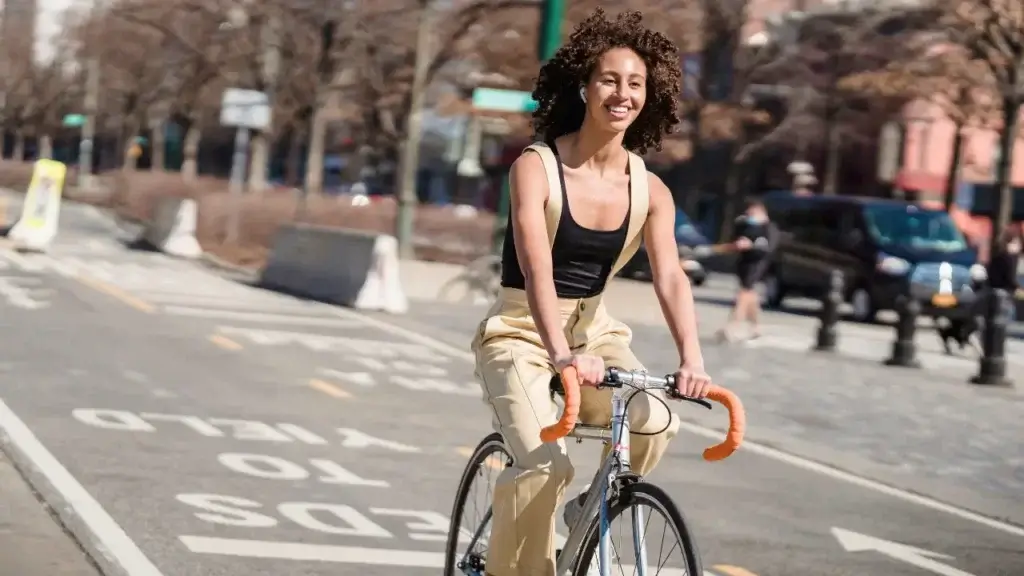
Image Credit: Canva
If there’s one city in the U.S. that wears the crown for bike-friendliness, it’s Portland. Often dubbed “Bike City USA,” Portland has made biking not just practical but incredibly enjoyable. Whether you’re a hardcore cyclist or just someone looking for a fun, eco-friendly way to get around, this city rolls out the red carpet—literally—with over 400 miles of bikeways.
So, do you need a rental car when Portland’s cycling infrastructure is this good? Probably not.
Meet Biketown
Biketown is Portland’s official bike-share program, operated by Lyft. It offers thousands of electric-assist bikes conveniently located across the city. You can grab a bike at a docking station, ride wherever you like, and return it to any station. The e-assist feature is especially handy for tackling the city’s occasional hills.
Pricing is budget-friendly: you pay $1 to unlock a bike, then $0.20 per minute. For frequent riders, a monthly membership is also available for around $19/month. It’s perfect for commuting short distances or just cruising along the waterfront.
Best Biking Routes
- Springwater Corridor – A scenic, paved trail stretching from downtown to the suburbs. Think trees, rivers, and quiet.
- Eastbank Esplanade – Great for casual rides with river views and pedestrian bridges.
- Tilikum Crossing Bridge – A car-free bridge exclusive to pedestrians, bikes, and transit.
Safety First
Portland takes cycling safety seriously. You’ll find green-painted bike lanes, separate bike signals at intersections, and even entire bike boulevards designed for low-traffic use. Helmets aren’t required by law for adults, but it’s still wise to wear one.
Pro tip: Download the Ride with GPS app for easy-to-follow, pre-mapped Portland bike rides.
Bottom line? Unless you plan to bike up a mountain or carry a bunch of luggage, you won’t miss a rental car at all. Biking here is fun, freeing, and part of the Portland experience.
Ridesharing and Carsharing Options
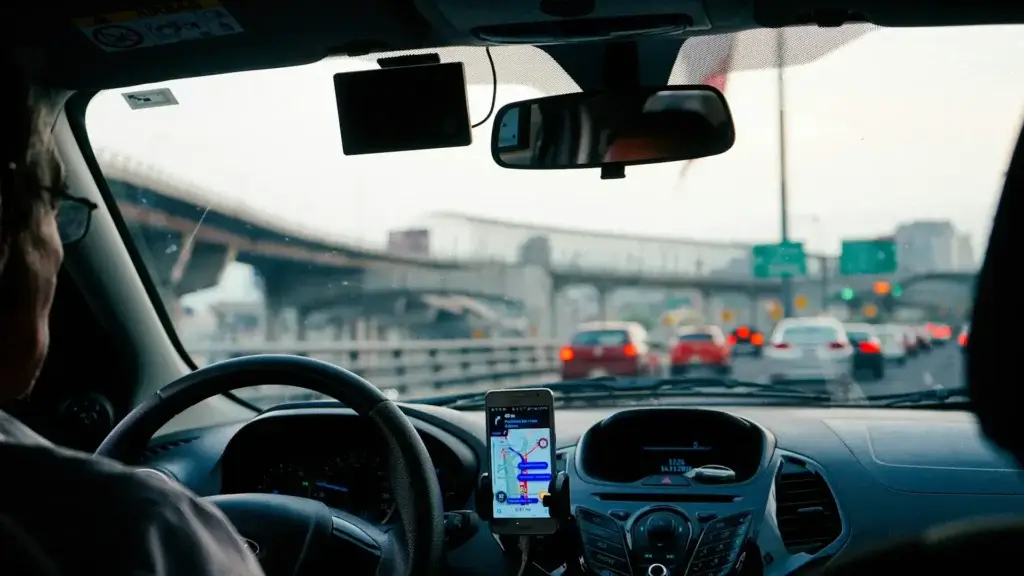
Image Credit: Unsplash
Don’t feel like biking or navigating transit? No problem. Portland is fully plugged into modern rideshare and carshare networks, making it incredibly easy to get from point A to B without owning—or renting—a car.
Uber and Lyft Availability
Both Uber and Lyft operate extensively in Portland. Whether you’re leaving the airport, heading to dinner, or bar hopping on Alberta Street, you’ll usually find a ride within minutes. Prices are pretty standard compared to other major U.S. cities, but can surge during rush hour or late-night weekends.
When to Use Rideshare
- Heading out late at night
- Traveling in a group
- Visiting locations not well-served by transit
- Going short distances quickly (like from downtown to Mississippi Ave)
Carsharing Options
Prefer to drive yourself, but only now and then? Check out these carsharing platforms:
- Zipcar – Cars are parked all over the city and can be rented hourly or daily. You pay a monthly fee plus per-use charges.
- Turo – Think Airbnb for cars. Rent cars directly from locals, often at a better price than traditional agencies.
- Getaround – Similar to Zipcar but app-based and often more flexible.
Carsharing is especially useful for occasional excursions. For example, you could rent a Zipcar for the day to visit Mt. Hood, then return it and go car-free the rest of your stay.
Compared to a full-on car rental, carsharing is more flexible, more affordable, and better aligned with Portland’s green ethos. Use it when you need it, and forget about parking, insurance, and fuel the rest of the time.
Renting a Car – When it Makes Sense
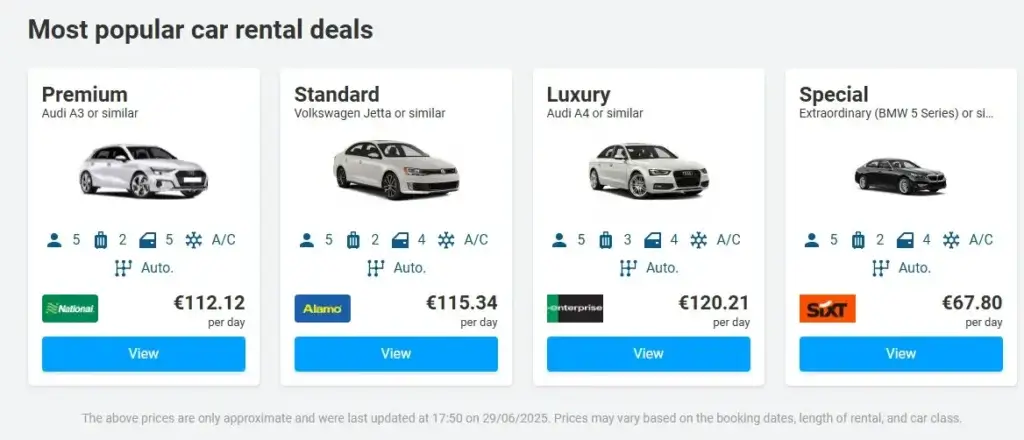
Image Credit: Discovercars
Even though Portland is super easy to navigate without a car, there are times when renting one is totally worth it.
If your trip includes multiple day trips outside the city or you’re staying somewhere more remote—say, a cozy cabin in the woods or a vacation rental far from a MAX line—having a car becomes a game-changer.
Also, if you’re someone who likes to explore spontaneously, a rental gives you the freedom to chase waterfalls (literally) or pull over at scenic overlooks without planning every bus transfer.
Here’s when a rental makes sense:
- You’re planning to drive the Oregon Coast Highway
- You want to hike in the Columbia River Gorge
- You’re skiing or snowboarding at Mt. Hood
- You’ve got a lot of gear or luggage
- You’re traveling with kids or elderly relatives who need flexibility
But don’t make this mistake: Many people rent a car for their entire stay and then realize it sits unused most of the time. If you’re going to be in Portland for 5 days but only need the car for 1 or 2, you’re better off mixing rideshare and transit with a one-day rental.
Top Day Trips Requiring a Car
- Columbia River Gorge – Home to over 90 waterfalls including the iconic Multnomah Falls, the Gorge is stunning but not easily accessed without wheels. Sure, there’s the Columbia Gorge Express, but driving gives you the freedom to stop and explore.
- Oregon Coast – Cannon Beach, Seaside, and Tillamook are just 1.5 to 2 hours away, but they’re not easily reachable without a car unless you join a tour.
- Mt. Hood – Ski in the winter or hike in the summer. Either way, it’s a 2-hour drive from downtown and way easier with a car.
- Willamette Valley Wine Country – With dozens of wineries spread across the countryside, you’ll need a car (or designated driver) to fully enjoy this region.
Car Rental Costs and Availability
On average, renting a standard car in Portland will cost you around $45–$70 per day, depending on the season and vehicle type. During peak travel times like summer or major festivals, expect prices to surge—especially if you book last minute.
Where to Rent
- Portland International Airport (PDX) – Most convenient but can be pricier
- Downtown locations – Usually offer better rates and allow flexible pickups
- Peer-to-peer apps like Turo – Often cheaper and more personalized
Don’t forget: many rental companies also require a credit card, valid driver’s license, and a security deposit.
Tip: Use aggregator sites like Discovercars or Expedia to compare rental prices before you book.
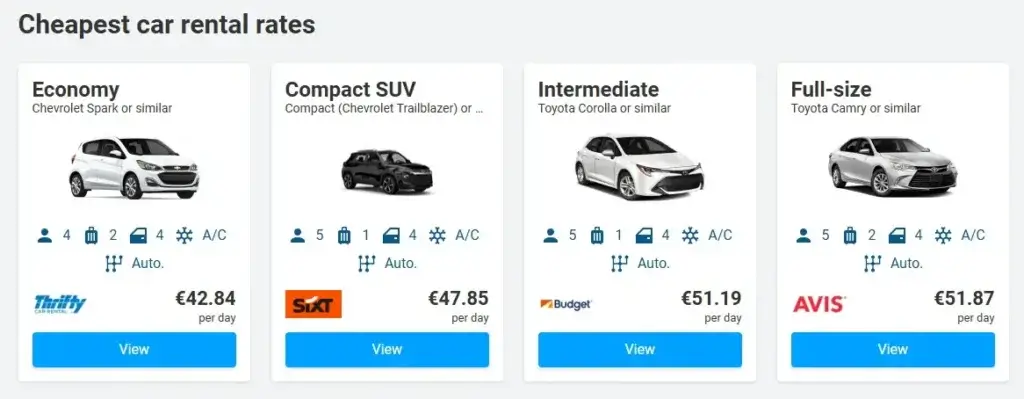
Image Credit: discovercars
Parking in Portland – What You Should Know
So, let’s say you go ahead and rent a car in Portland—what about parking? This is where things can get a little tricky. While not as painful as in larger metro areas like San Francisco or New York, parking in Portland comes with its own set of challenges and costs.
Downtown Parking:
Metered parking is common in the downtown core and popular areas like the Pearl District and Northwest 23rd. Rates range from $1.20 to $2.00 per hour, depending on the zone and time of day. Time limits also apply—most metered spots allow you to park for 2 to 4 hours.
Parking meters accept cards, coins, and payments via the Parking Kitty app. This app is a lifesaver because it lets you extend your time remotely—no more running back to feed the meter!
Hotel Parking Fees:
If you’re staying in a downtown hotel, don’t assume free parking is included. Many charge $20 to $45 per night for valet or self-park options. That’s a big chunk of change, especially if you won’t be using your car daily.
Residential and Street Parking:
In neighborhoods like Alberta, Mississippi, and Hawthorne, street parking is more available—but still competitive during peak hours. Watch for permit-only zones and street cleaning signs to avoid tickets.
Garage Parking:
There are several public garages across the city, and they usually offer better rates for extended parking. Expect to pay $10–$18 for all-day parking.
Bottom line: If you’re planning to rent a car, budget an extra $10–$45 per day for parking. And always read parking signs carefully—Portland is notorious for ticketing and towing.
Challenges of Driving in the City
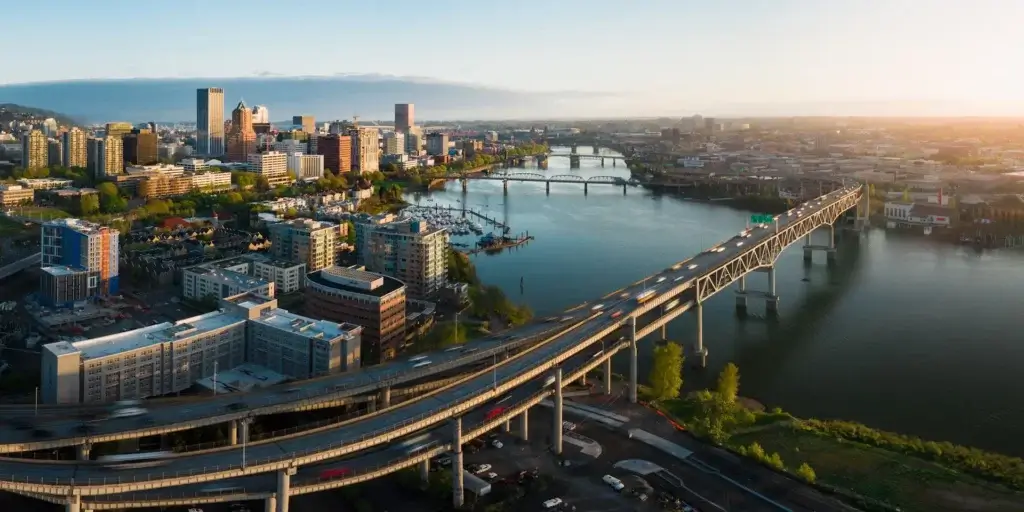
Image Credit: Unsplash
Driving in Portland isn’t impossible—but it’s not exactly a dream either, especially if you’re not used to the layout. Here are some real-world challenges that visitors often face:
1. One-Way Streets:
Portland’s downtown is filled with one-way streets that can trip up even the most experienced drivers. GPS helps, but it’s easy to miss turns and end up circling several blocks.
2. Narrow Lanes and Bike Traffic:
Many roads, especially in central neighborhoods, are narrow and shared with bike lanes. While it’s a great thing for cyclists, drivers need to stay ultra-aware.
3. Frequent Construction Zones:
Portland is always upgrading its infrastructure, so expect detours, lane closures, and confusing signage—especially near bridges and river crossings.
4. Pedestrians and Bikes:
The city’s walkability and biking culture mean you’ll encounter people crossing the road everywhere. Crosswalks are frequent, and drivers are expected to yield—so drive cautiously.
5. Rain and Fog:
The Pacific Northwest’s famous weather can make visibility and road conditions tricky. If you’re not used to driving in rain or fog, take extra precautions.
Overall, driving in Portland requires a level of patience and awareness that not every traveler wants to deal with—especially if there are easier alternatives.
Eco-Friendly Travel Alternatives
Portland prides itself on being green, so it’s no surprise that the city offers multiple eco-conscious ways to get around. If you want to reduce your carbon footprint while exploring, you’ll have plenty of options:
Electric Scooters:
E-scooters are scattered across the city thanks to companies like Lime and Bird. Just download the app, scan, and ride. They’re ideal for short trips (1–2 miles), especially on warmer days.
Portland Streetcar:
Another green option, the streetcar loops through popular areas like South Waterfront, Pearl District, and NW 23rd. It’s electric, quiet, and convenient.
Green Transit Policies:
TriMet buses and MAX trains are powered by renewable energy, and the city has long-term goals to become carbon-neutral. By using public transit or bike-share, you’re contributing to a cleaner environment.
Sustainability Tips for Visitors:
- Bring your own reusable water bottle.
- Use transit or bike instead of renting a car.
- Support local eco-conscious businesses.
- Stay at green-certified hotels.
Portland doesn’t just offer sustainable travel options—it encourages them. You’ll blend right in with the locals by choosing an eco-friendly way to explore.
Real Traveler Opinions
Still unsure about skipping the rental car? Let’s hear from real travelers who’ve done it both ways. Reddit forums and travel blogs are packed with useful insights from people who’ve been there and done that.
Traveler #1 – No Car Needed:
“We spent 5 days in Portland and didn’t rent a car. Used MAX from the airport, walked a lot, and took a few Ubers. It was perfect for a low-stress, urban trip.”
– u/pdxexplorer on Reddit
Traveler #2 – Wish I Didn’t Rent:
“Rented a car for the week, but honestly didn’t need it. It sat in the hotel garage most of the time. Next time I’ll just rent for the day if I go to the Gorge.”
– Travel blog comment
Traveler #3 – Mixed Approach:
“We rented for one day to go to Multnomah Falls and Mt. Hood, then used transit and bikes the rest of the time. Perfect combo.”
– Local forum user
Local Advice:
Even Portlanders say most visitors don’t need a car unless they’re doing outdoor adventures. One-third of Portland residents don’t own a car—and they get by just fine.
Moral of the story? Real-world travelers tend to agree: Unless you’re heading out of town, a car isn’t necessary.
Final Verdict – Should You Rent a Car in Portland?
Let’s break it down once and for all.
Don’t Rent a Car If:
- You’re staying within Portland’s urban core
- You want to explore on foot, by bike, or using transit
- You’re planning a short stay focused on city attractions
- You’re trying to save on parking and rental fees
Do Rent a Car If:
- You plan to do day trips to Mt. Hood, the Coast, or Wine Country
- You’re traveling with a large group or family
- You’re staying outside the city in a more remote area
- You value flexibility and spontaneity over cost savings
Still not sure? A hybrid approach might be best. Use public transport and rideshare for your city days, then rent a car just for your excursions. That way, you enjoy the best of both worlds without overpaying or stressing about where to park.
Conclusion
Portland isn’t just easy to explore without a car—it’s almost designed that way. With a top-notch public transit system, bike-friendly roads, and endless walkable neighborhoods, you can experience the city in a way that’s cheaper, greener, and often more fun than sitting in traffic.
A rental car can be useful—especially for trips beyond the city—but for most travelers? You absolutely don’t need one. Plan smart, stay central, and you’ll be able to soak up the best of Portland without ever turning a key in the ignition.
FAQs
1. Is public transit safe in Portland for tourists?
Yes, Portland’s transit system is generally safe and clean, especially during daylight hours. Stick to well-lit stops and use common sense like you would in any major city.
2. Can I visit Multnomah Falls without a rental car?
Yes! You can take the Columbia Gorge Express bus from Gateway Transit Center, or join a guided tour that includes transportation.
3. What’s the cheapest way to get around Portland?
Public transit is the most budget-friendly option. A day pass costs just $5.60 and covers MAX, buses, and streetcars.
4. Are Portland’s bike lanes safe for beginners?
Absolutely. Portland is one of the most bike-friendly cities in the U.S., with dedicated lanes, bike signals, and plenty of signage to guide you.
5. When is the best time to avoid renting a car in Portland?
Spring through fall is perfect for going car-free, thanks to mild weather and lots of outdoor activity options accessible by transit or bike.

